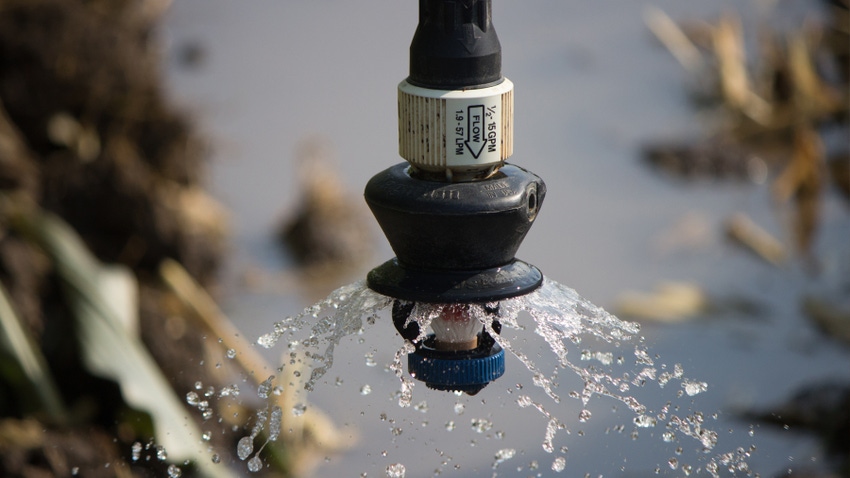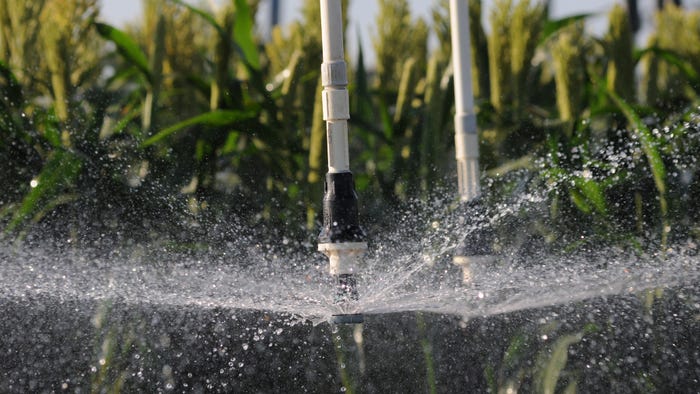
Efficiency is key to any sustainable farm. But when that farm is facing water limitations, it’s even more critically important to make irrigation decisions that will effectively use the water that’s available. And for those above the Ogallala Aquifer, the time to boost efficiency is now.
And each farmer, in each of the eight states, has a different strategy for irrigation water conservation.

STATE BY STATE: Available aquifer water varies state by state, and farmers use the tools and techniques that work for them, as in this field of Nebraska corn. (Curt Arens)
Nebraska’s approach
There are approximately 1.1 million irrigated acres in the portion of the Republican River Basin within Nebraska. According to the Upper Republican Natural Resources District (the district) based in Imperial, Neb., which covers Chase, Dundy and Perkins counties, this represents the largest area of regulated groundwater use in the eight states that are over the massive Ogallala Aquifer. The district has maintained a groundwater level measurement database for more than 400 irrigation wells, measured twice annually, going back 52 years.
The first control area, the first and second special protection areas and the first three integrated management plans have been in the Republican Basin. Actions such as allocations, temporary suspension of irrigation well drilling and the first moratorium on drilling all occurred here. In addition, 33,000 acres have been enrolled in the Nebraska Conservation Reserve Enhancement Program in the basin to temporarily retire irrigated acres.
Today, irrigators within the 1.73 million-acre district operate with a five-year groundwater allocation of 62.5 inches, or roughly 12.5 inches each year — 43% less than the first allocation was when it was implemented in the district in 1979. To stay within these limits requires precision monitoring and a change in the way farmers plan their crop rotations.
Irrigators may not always like restrictions, but they understand the need to preserve groundwater resources. “In an effort to conserve water allocation, some farmers introduce lower-water-use, small-grain crops into the more traditional corn-on-corn or corn-soybean rotation,” says Jasper Fanning, the district’s general manager. “Use of drought-tolerant corn varieties is common, as are variable seeding rates that incorporate differing moisture-holding capacities of soils across a field to increase water use efficiency.”

SPLIT CROPS: Some western Kansas farmers find splitting their irrigation circles between two crops, such as sorghum and corn, allows them to apply their limited water on half of the circle at the time that the specific crop needs it most for development. (K-State News Service)
Fanning says strip tillage is the prominent system in the area, but no-till is gaining, and conventional tillage is uncommon. “Reducing acres that are irrigated by taking off pivot end guns, or using allocation from less productive fields on their better fields, are other practices,” he explains. “Some farmers have retired pivots through our retirement program, making them dryland fields instead. We have offered pivot retirement incentives on fields where water use has high impacts on stream flow.”
Have these and other practices implemented in the district had an impact? “The areas that experience the sharpest [groundwater level] decline rates have a high density of irrigated land that was mostly developed before the district had the ability to control development,” Fanning says. “Our focus is to slow the rate of decline, which we have been able to do through programs and incentives we have in place for our water users.”
Thanks to the well measurements going back to 1972, URNRD has the most precise groundwater model possible for the district, Fanning acknowledges. “We’ll be able to use it to better manage groundwater declines and protect existing uses while also allowing new uses or changes in water use.”
Kansas cropping
Irrigation pivots have been a regular sight surrounding Johnson City, Kan., for decades. But farmers like Brant Peterson have had to adjust their irrigation methods in response to declining wells drawing from the Ogallala Aquifer.
Rather than shutting down irrigation completely, Peterson has found a way to strategically use his water through split applications on his pivots. He plants one half of the pivot to corn, and the other half to sorghum or another crop ideal for a dryland or limited-irrigation scenario. The two crops use water at different growth stages, which means he can apply his water when the crop will best use it, and limit waste.

NEW THOUGHTS ABOUT TOOLS: Farmers are rethinking the tools they use to irrigate their fields in low-water situations. (K-State News Service)
Peterson starts by planting his shorter-maturity irrigated corn at the front end of his planting window. “I prefer a corn in the 103- to 109-day range,” he says. “Then, I follow on the other side of the field with a sorghum variety.” He likes to plant his sorghum about the first or second week of June and chooses a variety that will mature before freeze. The variation in maturities means that when the corn is at tassel and in its peak water use, the sorghum hasn’t hit boot stage yet, he explains.
“You split your peak water use by using the two separate crops,” he says. This also helps manage his weed pressures, because he can rotate his crop protection products.
“Now you can flip-flop fields and stay away from a corn-on-corn issue, so you don’t have to buy heavier-traited products,” he says. He can also adjust his population, both of which save him seed costs. And most importantly, this still allows him to purchase multi-peril crop insurance for irrigated corn at his 200-bushel APH, even if his well pumping capability is reduced.
Peterson has also invested in improvements to his irrigation pivots to help ensure that they’re pumping and applying the water efficiently. He pays attention to nozzle spacing, uses Dragon-Line mobile drip irrigation, and uses tools to ensure the water reaches the end of the pivot span to water the most valuable parts of the field.
“You have to shift your mindset from ‘bushels per acre’ to ‘bushels per gallon’ while still maintaining your profitability,” Peterson says. He’s already farmed through three major droughts in Stanton County, and there will likely be more in the future. When it comes to water conservation, he says, his grandfather told him it’s better to manage as if you’ll not get the rain, than to rely on a rain that may never come.
About the Author(s)
You May Also Like








